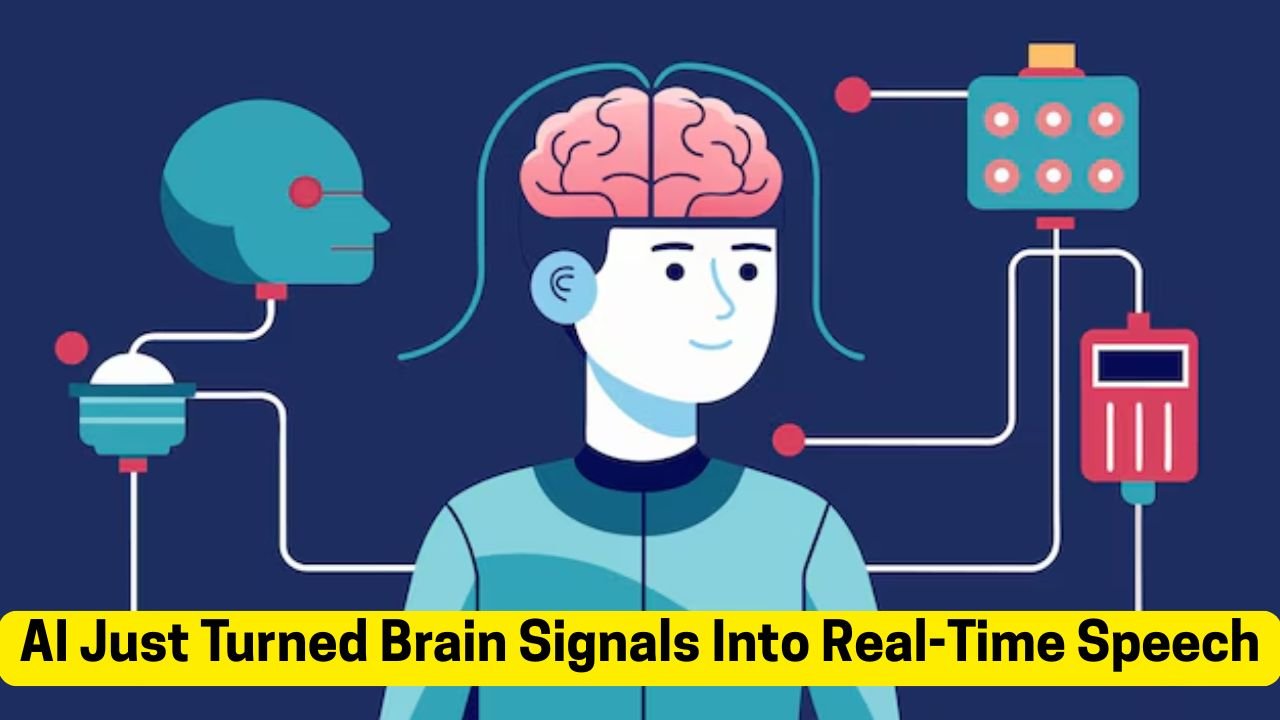Okay, so picture this: you lose your voice for 18 YEARS… and then suddenly, a computer reads your brain and starts speaking for you. No, this isn’t sci-fi. This just happened. For real. Scientists actually built an AI system that takes your brain signals and turns them into spoken words — in real time.
So yeah, the future is here, and it’s kinda wild. Let’s break this down, no nerd degree required.
 What’s the Hype About?
What’s the Hype About?
Researchers from UC Berkeley and UCSF just pulled off something huge. They created a brain-computer interface (BCI) that connects your brain to a speech-generating system. Basically:
Think → Brain sends signal → AI decodes it → Computer speaks it out loud.
All this happens in less than ONE second. That’s faster than some people can text back.
 The Main Character: A Real-Life Superwoman
The Main Character: A Real-Life Superwoman
So, the star of this story is a 47-year-old woman who had a major stroke 18 years ago. Since then, she couldn’t talk. Like, at all. But her brain? Still knew how to “speak.” It was just that the signals couldn’t reach her mouth.
So what did the scientists do?
They literally put electrodes in her brain (
), trained the AI to decode what she meant to say, and BOOM — she’s “talking” again. Through a computer.
And yeah — the AI even brought back her real voice, using clips from before the stroke. That’s some tearjerker stuff right there.
 Speed Check: How Fast Is “Real-Time”?
Speed Check: How Fast Is “Real-Time”?
Hold up, this isn’t some slow, robotic thing. The system clocks in at up to 78 words per minute — which is, no joke, faster than some people talk on FaceTime.
Most older tech for speech-impaired folks barely hits 10–15 words/min. This? This is a whole new game.
 How It Works (Without Getting Too Nerdy)
How It Works (Without Getting Too Nerdy)
Alright, TL;DR version:
- Electrodes go into your brain (motor cortex, to be specific).
- AI watches your brain signals as you try to say words silently.
- It decodes the vibes (aka neural patterns).
- A voice speaks your words out loud, instantly.
- Optionally: it speaks in YOUR old voice (
emotional damage).
It’s like your brain is texting, but way cooler.
 This Could Change So. Many. Lives.
This Could Change So. Many. Lives.
Think about everyone who can’t speak because of:
- ALS
- Spinal cord injuries
- Stroke
- Severe cerebral palsy
Now imagine they can communicate in full sentences, almost like before — and with their actual voice?? That’s next-level accessibility.
And like… imagine being able to say “I love you” to your fam again.
 But Wait, Is This Safe?
But Wait, Is This Safe?
Okay, so here’s the tea:
- This does need brain surgery (not super chill, tbh).
- The tech still needs to be customized for each person.
- Accuracy is around 75%, which is decent but not perfect. Sometimes it still messes up words.
So nah, you’re not downloading a “Brain-to-Speech” app anytime soon. But the signs are 
 What’s Next?
What’s Next?
This tech is giving futuristic-core, and scientists are already working on:
- Less invasive versions (like wearables — no skull-drilling pls).
- Faster AI training so it works for anyone.
- More natural voices + emojis
(okay, maybe not emojis… yet).
Also: imagine this hooked up to AR glasses or something. Silent convos in your head, anyone?
 The Vibe Check — Quick Facts
The Vibe Check — Quick Facts
| What’s Poppin’ | Status |
|---|---|
| Real-time speech? |  Yes Yes |
| Fast words per minute? |  Up to 78 WPM Up to 78 WPM |
| Personalized voice? |  Yup Yup |
| Needs surgery? |  Yeah Yeah  |
| 100% accurate? |  Not yet Not yet |
| Available in stores? |  We wish We wish |
 So, Can AI Read Minds Now?
So, Can AI Read Minds Now?
Kinda… but not in a scary “snoop on your secrets” way. It’s more like: your brain says “hello,” and the AI helps you actually say it — out loud. No mind-reading powers. Just a clever system that listens to the parts of your brain that would’ve moved your lips and tongue.
So yeah, your crush’s brain is still a mystery (for now).
 Final Thought
Final Thought
This isn’t just cool tech — it’s life-changing. Giving someone back their voice after 18 years? That’s more than innovation. That’s human. And it shows how far AI can go when it’s used for good.
So next time you think AI is just for making cat memes or deepfakes — remember this: it just helped someone speak again.
And that’s kinda beautiful.







